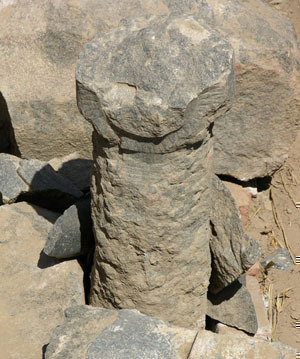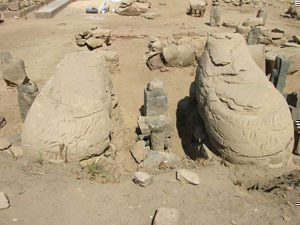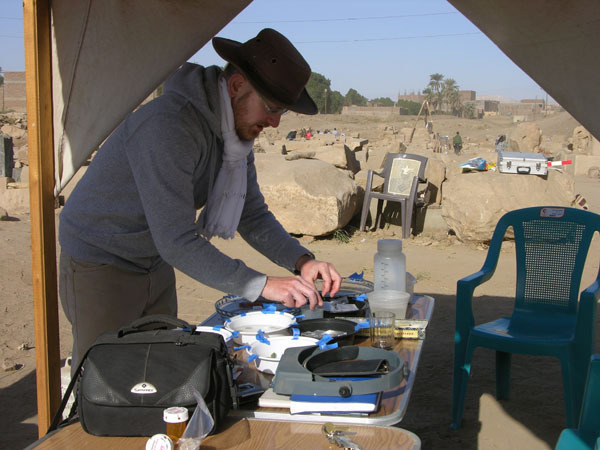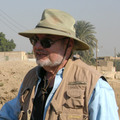The End of the Season
Thursday, February 28 was our last day of work. It has been a very satisfactory season. We accomplished most of what we set out to do, and more besides. Finding the footing of the Mut Temple’s 1st Pylon was particularly exciting, as was the successful restoration of Chapel D. We also found a new and interesting building in the last few days of work, described briefly below.
We want to give special thanks to the Luxor staff of Supreme Council of Antiquities who greatly facilitated our work: Mansour Boreik, General Manager for Upper Egypt; Mohamed Assem, General Manager for Luxor; Ibrahim Soliman, General Manager for Karnak; and our inspector Osama Abdel Maougoud Abdulla, with whom it was a great pleasure to work. And of course, nothing would have been possible without the hard work and dedication of our Egyptian technicians and workmen, to whom we owe many thanks.

Our most notable conservation project this season was the restoration of Chapel D. Here is the west wall of the first room in its final state. Its foundations are solid, its walls are vertical with the blocks properly aligned, and the spaces between the stones have been filled with a mortar tinted to match the sandstone. Khaled, Mohamed Gharib, Sayed Ahmed and their crew have done a wonderful job and we thank them for their efforts.

A simpler preservation task this year was to cover Temple A’s Forecourt with a bed of gravel, a method of preventing the growth of vegetation that has had some success in other areas of the Mut Precinct and Karnak.

We had hoped to finish clearing the area north of the east wing of the Mut Temple’s 1st Pylon this season, but as you may have gathered from earlier postings, the area is rather complex. It will take another season’s work to fully understand how the areas structures, seen here from the southeast, fit together.

The Taharqa Gate is open and there is now a clear view through it to Chapel D (on the left), the front area of the Precinct and Temple A to the east.


The north (top) and south (bottom) wings of the Taharqa Gate at the end of the season, with the paving fully exposed. The gate is almost 7 meters wide. The light on the north wing is generally good from about 9 am to noon, making photography easy. The south wing, however, gets no direct sunlight until mid-February and then only for about 30 minutes just after dawn, a very brief window of opportunity.

We know what the Taharqa led to (Temple A), but we don’t yet know what it led from, something that is critical to our understanding of the Precinct as a whole. We made a start this season, uncovering paving west of the gate that extends into the unexcavated earth further west. We need to explore this area more extensively next season.
The 2 holes behind the meter stick were used to bolt the doors of the gate shut and are further confirmation that the gateway originally had double doors.

On the rise of ground just north of the sacred lake and southwest of the Taharqa Gate were traces of a baked brick building. As a first step in trying to understand the northwestern area of the site, we decided to do a test clearing to see if it is worth investigating in detail. It’s a very interesting structure. In this view to the south you can see a well (left arrow), the remains of what may be a plaster-coated cistern (center arrow), and a room with a red-painted plaster floor (right arrow). Not visible is the round room south of the plastered room. All we know at this point is that the building probably dates to the Roman Period; figuring out its purpose — villa, a bath, or possibly a dye-making facility – will require further work.

This photograph looks east from the brick building to the west wing of the Mut Temple’s 1st Pylon and the rams before it. Under and to the south of the building is a wide area of mud brick that may be the remains of the wall that once ran from the north pylon of the Mut Temple (background) to the Precinct’s 18th Dynasty west enclosure wall. A centuries-old gully has washed out the rest of the wall between the brick building and the Mut Temple.


Sometimes the ancient recycling of sculptures in the Precinct was extreme. The small, rough column in the left photo was created from the upper half of a Sakhmet statue; you can still see part of her chin and mane. What building it once adorned is long gone, and it now stands between 2 of the rams in front of the Mut Temple (right). Restoration of these rams will be a challenge.
We could not have accomplished what we did this season without the expedition’s staff who volunteer their time, giving up warm beds and comfortable homes to come and work in the dust, heat and sun. They are a great team. We’ve thanked Ben Harer in an earlier posting, but want to thank the rest of the team here.

Bill Peck’s drafting talents were put to the test this year as we had very complex patterns of mud brick to draw in many areas, not to mention the various stages of the Taharqa Gate and its paving. Here Bill and I have a look at his last job, on his last day: the initial map of the newly-uncovered baked brick building described above.

As always, Elsie Peck did a superb job writing up the excavation records each day, a challenging and time-consuming task as it also involves cross-referencing the records of the objects and blocks found. The records she writes are the basis of our research once we get home. Her last task was to organize the small finds and pack them up, ready to go into storage.

On one of his last days, Jaap van Dijk sits under the watchful eye of a quartzite bust of Amunhotep III as he checks his records of inscribed blocks. Jaap’s extensive knowledge of Egyptian language and monuments make him an ideal object and block registrar.

This was John Steele’s first season with the expedition, and he adapted quickly to the challenges of field conservation. Working conditions weren’t always easy but he persevered with determination and good cheer.
Everyone but Mary and me will be gone by March 1. We have another 10 days in Luxor doing a number of mainly administrative tasks that are completely unphotogenic, so this will be our last Dig Diary posting.

We leave you with a final view out the gate of the Mut Precinct to the sphinx avenue and the Amun Temple to the north. The end of the season is always a little sad as we say goodbye to friends we won’t see until next year and to a site we all love.

Richard Fazzini joined the museum as Assistant Curator of Egyptian Art in 1969 and served as the Chairman of Egyptian, Classical and Ancient Middle Eastern Art from 1983 until his retirement in June 2006. He is now Curator Emeritus of Egyptian Art, but continues to direct the Brooklyn Museum’s archaeological expedition to the Precinct of the Goddess Mut at South Karnak, a project he initiated in 1976. Richard was responsible for numerous gallery installations and special exhibitions during his 37 years at the museum. An Egyptologist specialized in art history and religious iconography, he has also developed an abiding interest in the West’s ongoing fascination with ancient Egypt, called Egyptomania. Well-published, he has lectured widely in the U.S. and abroad, and served as President of the American Research Center in Egypt, America’s foremost professional organization for Egyptologists.
